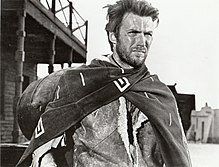
An antihero (sometimes spelled as anti-hero)[1] or anti-heroine is a main character in a narrative (in literature, film, TV, etc.) who may lack some conventional heroic qualities and attributes, such as idealism, and morality.[1] Although antiheroes may sometimes perform actions that most of the audience considers morally correct, their reasons for doing so may not align with the audience's morality.[2]
Antihero is a literary term that can be understood as standing in opposition to the traditional hero, i.e., one with high social status, well liked by the general populace. Past the surface, scholars have additional requirements for the antihero.
The "Racinian" antihero, is defined by three factors. The first is that the antihero is doomed to fail before their adventure begins. The second constitutes the blame of that failure on everyone but themselves. Thirdly, they offer a critique of social morals and reality.[3] To other scholars, an antihero is inherently a hero from a specific point of view, and a villain from another.[4] This idea is further backed by the addition of character alignments, which are commonly displayed by role-playing games.[5]
Typically, an antihero is the focal point of conflict in a story, whether as the protagonist or as the antagonistic force.[6] This is due to the antihero's engagement in the conflict, typically of their own will, rather than a specific calling to serve the greater good. As such, the antihero focuses on their personal motives first and foremost, with everything else secondary.[7]
- ^ a b "Anti-Hero". Lexico. Oxford University Press. Archived from the original on 6 August 2020. Retrieved 26 September 2020.
- ^ Laham, Nicholas (2009). Currents of Comedy on the American Screen: How Film and Television Deliver Different Laughs for Changing Times. Jefferson, North Carolina: McFarland & Co. p. 51. ISBN 9780786442645.
- ^ Kennedy, Theresa Varney (2014). "'No Exit' in Racine's Phèdre: The Making of the Anti-Hero". The French Review. 88 (1): 165–178. doi:10.1353/tfr.2014.0114. ISSN 2329-7131. S2CID 256361158.
- ^ Klapp, Orrin E. (September 1948). "The Creation of Popular Heroes". American Journal of Sociology. 54 (2): 135–141. doi:10.1086/220292. ISSN 0002-9602. S2CID 143440315.
- ^ Waskul, Dennis; Lust, Matt (August 2004). "Role-Playing and Playing Roles: The Person, Player, and Persona in Fantasy Role-Playing". Symbolic Interaction. 27 (3): 333–356. doi:10.1525/si.2004.27.3.333. ISSN 0195-6086.
- ^ Petersen, Michael Bang (2019). "An Age of Chaos?". RSA Journal. 165 (3 (5579)): 44–47. ISSN 0958-0433. JSTOR 26907483.
- ^ Klapp, Orrin E. (1948). "The Creation of Popular Heroes". American Journal of Sociology. 54 (2): 135–141. doi:10.1086/220292. ISSN 0002-9602. JSTOR 2771362. S2CID 143440315.